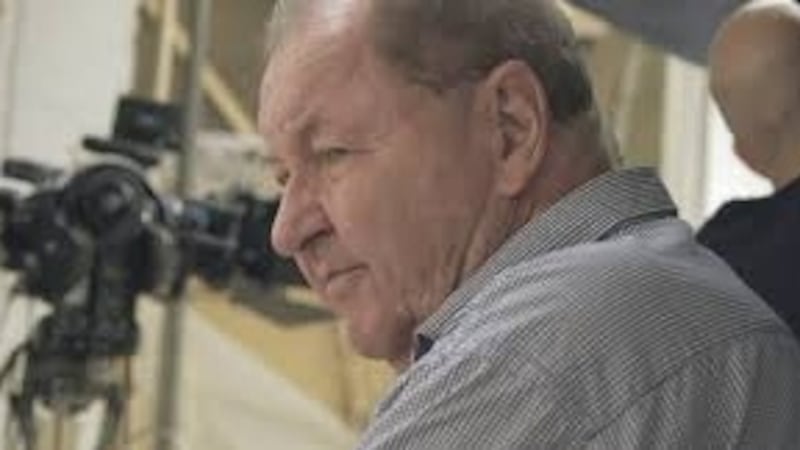Roy Andersson, the Swedish director of A Pigeon Sat on a Branch Reflecting on Existence and Songs From the Second Floor, is a most enigmatic presence in contemporary cinema. At 77, he has presided over a hugely influential body of work, albeit one that amounts to no more than six feature films. A quarter of a century passed between the release of his critically dismissed feature Giliap in 1975 to the wonderful Songs from the Second Floor in 2000.
To date, Andersson has won a Jury Prize at Cannes, the Lenin Award, and the Golden Lion for Best Film at Venice, but the filmmaker remains as mysterious as he is celebrated. Until now.
Watching Being a Human Person, Fred Scott’s new documentary portrait of Andersson, is often like seeing a first glimpse of the miniatures of Ray Harryhausen in a making-of special. Or indeed like looking at that much-reproduced image of Boris Karloff in full Frankenstein makeup holding a teacup and saucer between takes.
As Being a Human Person recounts, the precision of Andersson’s surreal, empathetic, poignant film-making requires meticulous trompe l’oeil. Every dreary high-rise horizon, every traffic jam, every drab flat is lovingly manufactured in Andersson’s Studio 24, the huge central Stockholm townhouse he acquired in 1981. Prop designers hunt for months to find a particular lampshade. Everything in the frame is meticulously calibrated for deadpan humour and quiet devastation.
I had to learn very quickly how things were changing
Watching Being a Human Person, one thinks more of the staging favoured by famous painters – Caravaggio and his proletariats, Edward Hopper and his wife Josephine – than of noted filmmaking sticklers like Stanley Kubrick.
‘Time of flux’
“That painterly approach is so intriguing,” says Scott. “The way he stages those quotidian moments in life and the way he draws from the world is testimony to Roy’s sensitivity as a person as well as a film-maker. It is like the studio of a traditional painter like Rembrandt. You have this team of people around him all working in service of the artist and the artist’s vision. The nearest comparison in film-making might be in animation. Perhaps somewhere like Aardman Studios. I thought it was important to try and record this. But that idea became harder to stick to as it turned out I had arrived at an interesting time of flux. And I had to learn very quickly how things were changing.”

Not too far into Being a Human Person it becomes clear that all is not well at Studio 24. As Andersson embarks on what is reportedly his final film, he maintains his established practices and daily rituals. Every day he watches people passing by from his office on the upper floors. He wanders to the Italian eaterie across the road: that establishment now houses his Golden Lion. A couple of days a week he goes to the 7/11 at the end of the block and drinks coffee while he reads the newspaper and again stares at people going past. But there’s a new nervousness among the crew. Both producer Johan Carlsson and Andersson’s daughter Sandra express concern for the director’s health and his increasing dependence on alcohol.
“I didn’t know,” says Scott. “I had read articles on Roy that mentioned his historical battles with depression. But I wasn’t aware of the drinking problem. One of the original ideas for the documentary was to make it a bit more conceptual. But when the alcoholism was raised I realised that had to be part of the narrative. It had to be included in the most sensitive way possible.
“I didn’t want to make a hagiography but I didn’t want to take advantage. But the problem totally defined how they worked from that point on. And to not have that part of the story would not have been an authentic representation of what I witnessed when I was there.”
Alcohol and boredom
Some 16 months into filming over regular visits to Stockholm, Andersson spoke about his alcoholism. The drinking is “to avoid boredom”, he says on camera. It’s a characteristically generous admission from someone Scott notes “would always give you time. If you bumped into him in the street, he would be interested in your life.”
Andersson’s films, accordingly, are heartfelt and almost unbearably human. Since 2000, his output has comprised a series of tableaux in which ordinary people – street casting has included everyone from a dentist to a retired embassy driver – cling to dignity to absurd, moving effect.
Dignity, sadly, is often just beyond reach. A man falls to his hands and knees and pleads with his boss after he is fired in Song from the Second Floor. A girl meets her rock star idol but he ditches her by giving her the wrong address in You, the Living. Two travelling novelty salesmen unsuccessfully attempt to woo customers with their tacky wares in A Pigeon Sat on a Branch Reflecting on Existence.
Ask Andersson what the films are about and he’ll likely cite the philosopher Martin Buber or Goethe. Songs from the Second Floor is organised around a quote from the Peruvian poet Caesar Vallejo: “Blessed is the one who sits down.”
I think there's an element of truth to the Bergman rivalry
A Pigeon Sat on a Branch Reflecting on Existence – Andersson’s fifth film in as many decades – was improbably inspired by Dutch master Pieter Bruegel’s 1565 painting The Hunters in the Snow. Andersson’s artist statement, released ahead of the film’s premiere, is as revealing as the director generally gets:
“In Hunters in the Snow, the birds appear to be speculating: ‘What are the humans doing down there? Why are they so busy?’ . . . A Pigeon Sat on a Branch consists of a bird’s panoramic view of the human condition, in which the bird not only reflects on human existence but also worries deeply about it, as I do myself. The pigeon is astonished that humans do not see an approaching apocalypse, though it is in man’s ability to avoid destroying the future for themselves. A Pigeon Sat on a Branch shows the looming apocalypse and offers the possibility to believe in our capacity to avoid it.”
Bergman as rival
Andersson’s career has been as circuitous as his influences. A lifelong Marxist, he was blacklisted by his former mentor, Ingmar Bergman, who was, by Andersson’s account, aggressive, egotistical and “very, very right wing”.
“I think there’s an element of truth to the Bergman rivalry,” says Scott. “He did blackball him. I think it’s probably a more exciting tale in the retelling. Roy has softened in his attitude to Bergman. He’s at that place in life and has moved on from it. He was telling me about his favourite Bergman films [Persona, The Seventh Seal and The Silence]. So I think he’s let go of that early bitterness. Bergman did say Roy would never work again. That was the original beef at film school. That Bergman would prevent Roy from pursuing a career. Or words to that effect. They are definitely not on the record.”

Against all odds, Andersson scored an extraordinary success with his debut feature. A Swedish Love Story won four awards at the 1970 Berlinale and was selected as Sweden’s Oscar entry for best foreign language film. Weirdly, Andersson found himself “disgusted” by the film’s success. His second feature, Giliap, was released after a protracted production in 1975. It was a critical and commercial disaster. The director retreated from features into advertising.
“After Swedish Love Story is when the first wave of depression hit,” says Scott, “He describes it as graduation depression. You’ve been building and building towards something. And when it happens it’s like falling off a cliff. After it, he went to live in a log cabin and he worked in a hotel bar. But that film had such a good reception and it set an expectation. The second film was a shock because it had completely the opposite reaction. He knew people in advertising and after Giliap the only work he could get was commercials. But that and the studio allowed him to develop his visual style.”
Cinema of compassion
Even in advertising, Andersson was capable of making waves. Something Happened, an educational short commissioned by the Swedish National Board of Health and Welfare as part of an Aids-awareness campaign, was cancelled. Andersson’s left-wing politics are still felt in his cinema. In About Endlessness, the second World War and Sweden’s part in that conflict is broached in an icy march and a post-Cologne bombing sequence. In A Pigeon Sat, pith-helmeted colonial troops lead African captives into a giant copper-horned drum that rotates and makes beautiful music as the people inside are roasted.
“When I was at film school – 20 odd years ago – I came across an old VHS copy of World of Glory,” recalls Scott. “And I was just completely blown away. It was bizarre and confrontational and also had such compassion. It changed the way that I looked at cinema. For years afterwards, Roy felt like a cherished secret. It was rare to meet anyone who knew his work.
“Songs From the Second Floor brought the new Roy – I suppose – into focus. But that film was a huge gamble. He put everything – literally everything – on it. It could have been a disaster. Nobody was making films like that. And even now, nobody else is making films like Roy.”
Being a Human Person ends with its subject winning at Venice. But the film marks the end of an era. Parts of Studio 24 will soon be sold off. Can this really be the end?
“I think the team around him doubt that he’ll ever make another feature again,” says Scott. “But if he never does make something again, I think it would be a tragedy.”
Being a Human Person and Andersson's latest film, About Endlessness, are available at Curzon Home Cinema





















